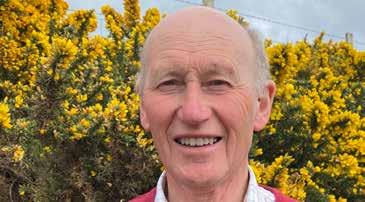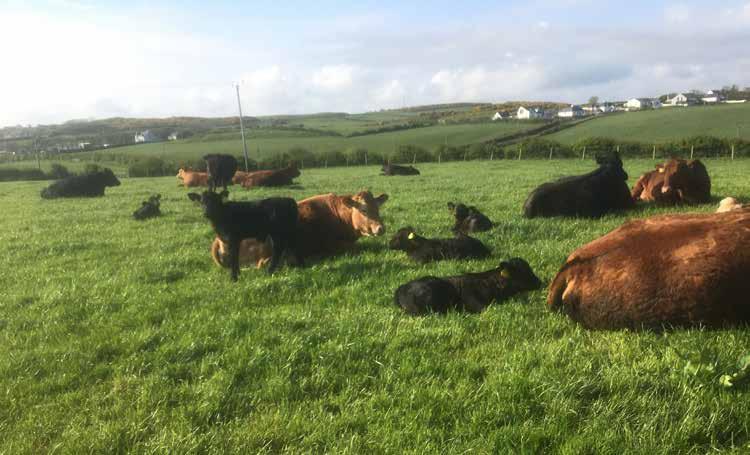

Sustainability focus drives switch to Aberdeen-Angus for dairy beef enterprise
A desire to reduce reliance on inputs and create a more sustainable dairy beef finishing system was the impetus for the Farrant family’s move to Aberdeen-Angus genetics.
The family partnership operates a dairy unit at Manor Farm in Eaton in Oxfordshire, and a dairy beef finishing unit at Underley Farm, near Tenbury Wells in Herefordshire.
The finishing enterprise is run by Ian Farrant, while the dairy unit is run by his cousin Andrew Farrant.
The dairy herd comprises 600 cows, which are predominantly a cross between Norwegian Red, New Zealand Friesian and Holstein, on a grazing-based system.
The herd operates blocks of spring and autumn calvers, with cattle milked twice-a-day on a 50-point Waikato rotary parlour. Average yields of 7,000 litres a cow are achieved, and all milk is sold to Waitrose.
All calves, other than replacement heifers, are sent to the finishing unit in Herefordshire where Ian finishes approximately 650-700 dairy cross Aberdeen-Angus calves and dairy steers a year.
The majority come from Andrew’s dairy herd, with the remainder sourced from Meadow Quality. Finished cattle are sold to
Waitrose, via its producer group Dovecote Park, and the family is currently in discussions to also supply finished cattle to regenerative farming collective, Grassroots Farming.
The switch to Angus
The move away from British Blue genetics to Aberdeen-Angus was driven by a desire to reduce reliance on inputs and finish the cattle on less cereals.
“British Blues have done us well in the past, but it became very clear that we were struggling to finish them,” explains Ian.
“When they got to 16-months-old we could finish them on a ration, but we ended up having to throw vast amounts of concentrates at them and they became less efficient.”
We’re trying to reduce our reliance on inputs, and the Angus seems to fit a more sustainable faming model,
says Ian Farrant
He says becoming an AHDB Beef and Lamb monitor farmer in 2021 also focused minds, and analysis of the business revealed it could only expand by buying in more concentrates to finish calves.
“Instead of growing the business, I felt we should maybe reduce our numbers and become more self-sufficient in our feed,” adds Ian.
“That’s where the Aberdeen-Angus came in; we’re trying to reduce our reliance on inputs, and the Angus seems to fit a more sustainable faming model.”
Dairy benefits
The Farrants say the benefits offered by Aberdeen-Angus are seen across their business, from when the cows calve down right through until when their calves are finished.
Andrew says: “All our breeding is done by AI, and bull choice is very much down to calving ease.
“We use the same Aberdeen-Angus bulls across both cows and heifers, and the calves just seem to pop out.”
He says figures for the 2023 spring-calving block show that from 196 calvings to Aberdeen-Angus bulls, they achieved 198 live calves, due to some sets of twins being born.
As well as calving ease benefits, Andrew says he has been impressed with the vigour of the Aberdeen-Angus cross calves.
He adds: “The calves seem to get up straight away and have a drink of colostrum.
“Another benefit is that they are polled cattle. We always choose polled dairy bulls too, and we haven’t had to dehorn a calf in the past two years.”
We use the same AberdeenAngus bulls across both cows and heifers, and the calves just seem to pop out,
Finishing benefits
“Since moving to Aberdeen-Angus we’re using far less cereals – I estimate we only need a third of the amount to finish the Angus cattle compared to the Blues.”
He says the Aberdeen-Angus crosses are finishing at carcase weights of 315-320kg, at grades ranging from a mid R to an O+.
Although this is slightly lighter than the Blues, which had average carcase weights of 330-335kg, at typically half a grade higher than the Angus crosses, Ian says he is happy with the end result and not interested in pushing for heavier cattle.
He adds: “I’d rather have a higher throughput and sell them slightly lighter, because there’s huge potential to lose money in the finishing shed, especially with heavy cattle.”
Praising the working partnership between the Farrant cousins, AHDB knowledge exchange manager for beef and lamb, Emma Steele, says: “One of the things that works really well with Andrew and Ian is that they sit down quite regularly as a partnership and discuss what’s gone well and what hasn’t.
“It’s a constant review process and is proving successful; it would be great to see more of this collaboration between dairy farmers and dairy beef finishers.”
Since moving to AberdeenAngus we’re using far less cereals, and I estimate we only need a third of the amount to finish the Angus cattle compared to the Blues,
says Andrew Farrant says Ian Farrant
Once the calves are moved to Herefordshire for finishing, Ian says there is a noticeable difference in the amount of concentrates they require for finishing.
Ian says: “Our business is essentially split into three areas – calf rearing, growing, and finishing.
“The Aberdeen-Angus crosses spend 30-60 days on the finishing ration and they’re achieving an average daily liveweight gain (DLWG) of 1.5-1.8kg, based on a grass and maize silage-based diet, with about 4kg of cereals a day.”
He says this compares to the British Blue crosses which spent 60-90 days on the finishing ration and achieved an average DLWG of 1.4kg.
Ian adds: “The weight gain was fine, but the problem was the length of time they were spending on the finishing diet.



Aberdeen-Angus genetics enable outwintering in far north
The hardy nature of Aberdeen-Angus cattle, coupled with their ability to thrive on grass, is enabling a farmer in the most northerly region of the UK to outwinter his herd.
Jamie Leslie runs a herd of 90 Aberdeen-Angus suckler cows and a flock of 1,000 April-lambing ewes at the 860-acre Scholland Farm, near Virkie on mainland Shetland.
All cattle are either kept for breeding or are finished on-farm to supply Sound Butchers in Lerwick, while lambs are finished on grass, if it is available, or sold store.
Mr Leslie, who has won several industry awards in recent years, has significantly reduced winter housing costs through strict selection and a focus on grazing.
Move to outwintering
High transport costs for bringing inputs to the Shetland Isles was the impetus for Mr Leslie’s move to outwintering and making the most out of home-grown forage.
“Over the last few years, I’ve been using budgeting software Farmax to plan and model the farm business,” says Mr Leslie.
“Winter housing was identified as one of the main drains on costs, so I’ve worked to minimise the time cattle spend inside.
“This has largely been possible due to the hardy nature of the Aberdeen-Angus cattle and the breed’s ability to thrive on grass.”
The herd is now grazed outside for nine months of the year, and they are only housed for calving in the spring – a move which has delivered cost savings of £98 per cow in the past.
Bulls are selected for positive fat and intramuscular fat (IMF) with a lower mature cow weight.
Breeding the right cow
A strict selection and breeding policy is key to being able to run a herd outside on a farm so far north, says Mr Leslie.
“Bulls are selected for positive fat and intramuscular fat (IMF) with a lower mature cow weight,” he adds.
“This gives us a cow that is easy-fleshing, with a decent level of IMF, and not too big.
“Selection for positive fat means cows have a body condition score of 4 at weaning time; this gives them a reserve over winter.”
When it comes to breeding, Mr Leslie gives replacement heifers six weeks with the bull, while mature cows are given nine weeks to get in-calf.
He tends to buy bulls privately and aims to have his replacement heifers calving down at two-years-old.

Making the most from grass
Cows are calved in March with the aim of supplying 15-16-month-old grass-finished steers to Sound Butchers from July the following year.
They are turned out onto sand dunes in April once they have calved, and once in-bye grass growth starts in May, Mr Leslie runs a rotational grazing system.
Ewes and lambs are brought into the rotation at the beginning of June and grazed on a leader-follower system with the cows.
Explaining how the system works, Mr Leslie says: “Ewes graze each paddock for two days – giving them the best grass and driving their lactation – and the cows and calves follow the sheep by grazing the remainder of the grass over the following two days.”
The system runs until August when lambs are weaned, after which cows and calves stay on the rotational grazing system until weaning in the middle of October.
Mr Leslie says this approach ensures calves have access to better-quality grazing as they start to transition from their mothers’ milk to a complete-grass diet.
“At weaning, cows move to grass that’s been deferred over the summer and stay out until early February eating a combination of deferred grass, hay, straw, and silage,” he adds.
Winter housing was identified as one of the main drains on costs, so I’ve worked to minimise the time cattle spend inside. This has largely been possible due to the hardy nature of the Aberdeen-Angus cattle and the breed’s ability to thrive on grass.”

Selection for positive fat means cows are body condition score 4 at weaning time; this gives them a reserve over winter.”
Finishing policy
At weaning time, calves are split into steer and heifer groups, with the heifers housed and the steers outwintered.
Mr Leslie says data for 2022 shows the average weaned weight for calves was 288kg, based on them getting no creep feed during the summer.
He says heifers are fed grass silage and 1.5-2kg of home-grown barley over the winter until late February, after which they are transitioned onto a silage-only diet.
The outwintered steers are fed fodder beet and a good-quality grass silage with the aim of achieving a daily liveweight gain of 0.6kg a day.
“While 0.6kg a day may not seem exciting to most, I find this sets the calves up to perform well on grass the following summer,” says Mr Leslie.
“As an example, I had some yearling steers housed in 2021 and the remainder were outside on beet – once they were all back out to grass, those that had wintered on beet peaked at daily growth rates of 1.98kg in June and July, which was 0.5kg a day higher than the housed steers.”
Mr Leslie aims to get the first of his steers finished in July at around 16-months-old to meet the butcher’s target of a 310kg carcase.
Thereafter, calves are marketed from grass until October when grass quality starts to drop, however growth rates are still running at around 1.1-1.2kg a day at this time of year, adds Mr Leslie.



